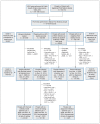Hepatitis C virus infection in First Nations populations in Ontario from 2006 to 2014: a population-based retrospective cohort analysis
- PMID: 34584007
- PMCID: PMC8486470
- DOI: 10.9778/cmajo.20200164
Hepatitis C virus infection in First Nations populations in Ontario from 2006 to 2014: a population-based retrospective cohort analysis
Abstract
Background: Hepatitis C virus (HCV) infection causes substantial morbidity and mortality in Canada and is of concern among First Nations communities. In partnership with the Ontario First Nations HIV/AIDS Education Circle, we described trends in HCV testing and epidemiologic features among Status First Nations people in Ontario.
Methods: In this retrospective study, we used health administrative databases for 2006-2014 in Ontario with 3 cohorts of Status First Nations people: those tested for HCV for the first time, those who tested positive for HCV antibodies or RNA, and those with no HCV laboratory or testing records. We examined cohort characteristics, and the annual prevalence and incidence of testing and diagnosis of HCV infection. Outcomes were stratified by region, sex and residence within or outside of First Nations communities.
Results: During the study period, 2423 Status First Nations people were diagnosed with HCV infection, 20 481 received their first test, and 135 185 had no test record. The point prevalence of ever having been tested increased from 6.3 (95% confidence interval [CI] 6.2-6.5) per 100 people in 2006 to 16.2 (95% CI 16.0-16.4) per 100 people in 2014. The point prevalence of diagnosed HCV infection increased from 0.9 (95% CI 0.9-1.0) to 2.0 (95% CI 1.9-2.0) per 100 people. The incidence of first test and of diagnosis increased from 12.1 (95% CI 11.5-12.6) to 21.3 (95% CI 20.5-22.1) per 1000 person-years and from 1.3 (95% CI 1.1-1.5) to 2.3 (95% CI 2.1-2.6) per 1000 person-years, respectively. Testing, diagnosis and prevalence of HCV infection were consistently higher among people living outside of versus within First Nations communities, but larger increases over time were observed among those living within First Nations communities.
Interpretation: Testing and diagnosis of HCV infection increased from 2006 to 2014 among Status First Nations people in Ontario. Our findings indicate the need for population-level efforts to eliminate hepatitis C in First Nations communities.
© 2021 CMA Joule Inc. or its licensors.
Conflict of interest statement
Competing interests: William Wong and Murray Krahn report research support from the Canadian Liver Foundation, outside the submitted work. Jordan Feld reports institutional research support from AbbVie, Enanta Pharmaceuticals, Gilead Sciences and Janssen, and consulting fees from AbbVie and Gilead Sciences. No other competing interests were declared.
Figures







Comment on
-
Health care costs associated with hepatitis C virus infection in First Nations populations in Ontario: a retrospective matched cohort study.CMAJ Open. 2021 Sep 28;9(3):E897-E906. doi: 10.9778/cmajo.20200247. Print 2021 Jul-Sep. CMAJ Open. 2021. PMID: 34584004 Free PMC article.
References
-
- Kelly-Scott K. Aboriginal peoples: fact sheet for Ontario. Ottawa: Statistics Canada; 2016. [accessed 2019 Mar 3]. Cat no 89-656-X2016007. Available: www.statcan.gc.ca/pub/89656-x/89656-x2016007-eng.pdf.
Publication types
MeSH terms
Grants and funding
LinkOut - more resources
Full Text Sources
Medical
